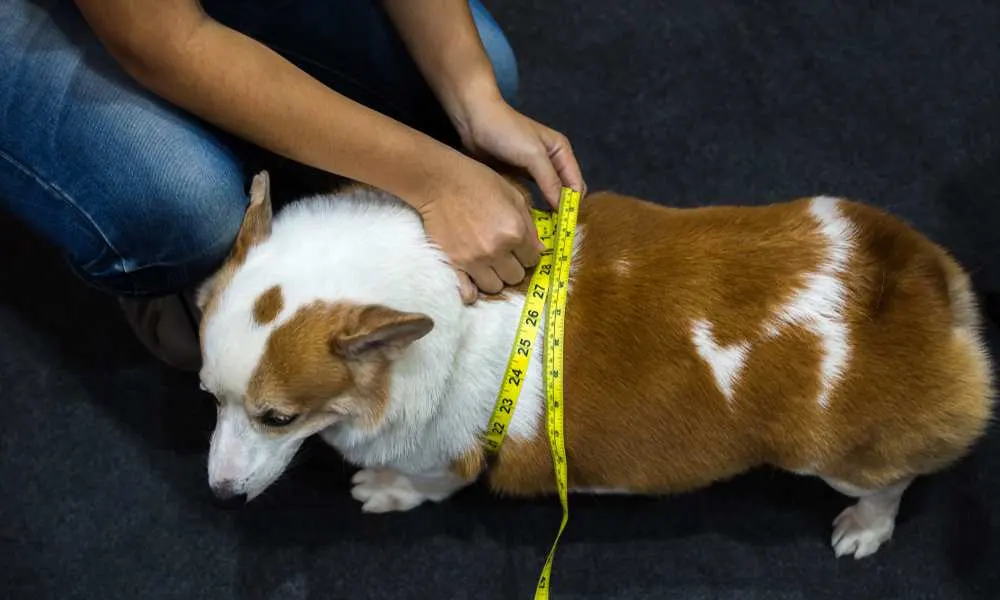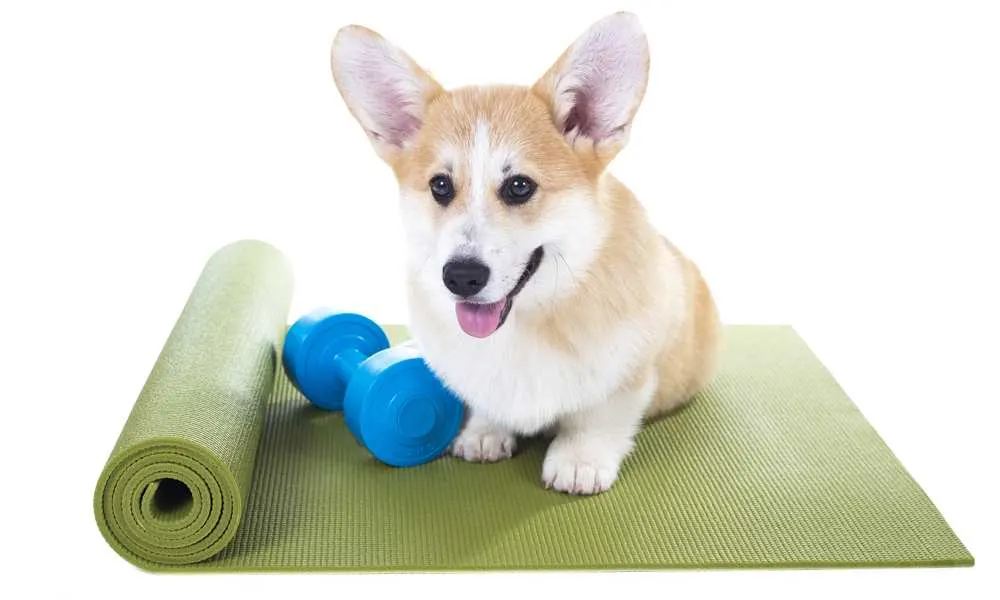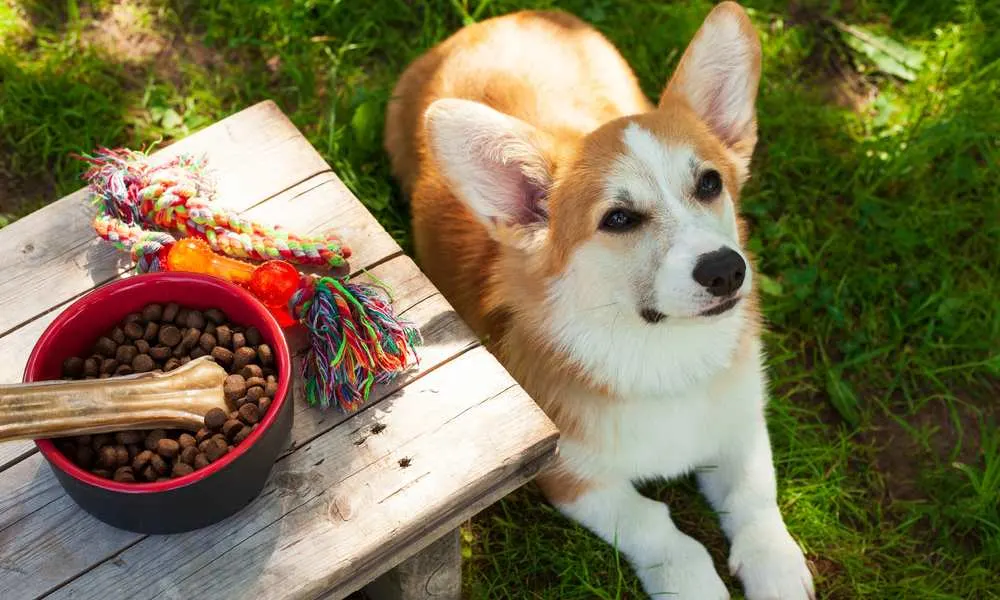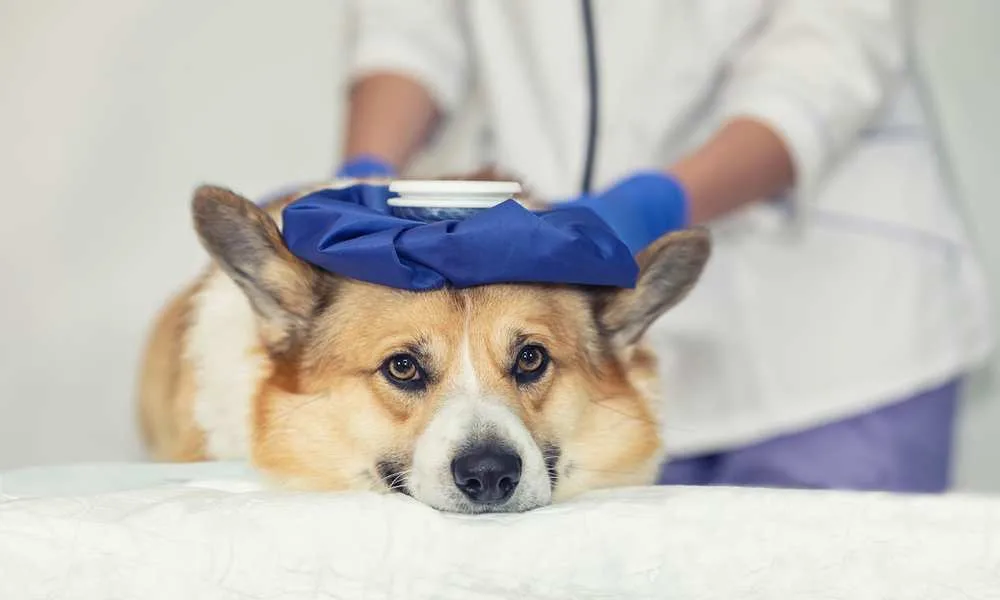Having a Corgi in the family is pretty much a recipe for happiness. They are cute and playful dogs that have a lot of love to give to each and every human that they meet. But there may come a time in which your furball is looking a bit slow and chubby.
Well, he has always looked a bit chubby; that’s just how Corgis are!
Hate to break it to you, but there is a good chance that your Corgi is overweight. But don’t worry!
Having an overweight dog is not the end of the world. We all have our chubby periods, and it really is nothing serious. But if it doesn’t get handled the right way – it can get pretty darn serious.
There is no upside to gaining more weight for a dog. There’s no upside for any living creature! Some people give their dogs too much food with an excuse like: well, I don’t want him to go hungry. And we get that!
You never know how much food is enough, and your Corgi eats like it’s his last meal, every meal. So why do they do this? Is your corgi really always hungry? We’ll try and get to the bottom of this. Also, if your dog is already overweight, worry not! We’ll give you an advice or two on this subject as well.
There is a lot of information that we need to go through. People don’t really get an instruction manual once the little Corgi becomes a part of the family, which is a shame. But we’ll try to give you a kind of a manual, as far as the weight is concerned.
Just remember to call your vet if you think that the overfeeding went a bit too far. There are some serious consequences for your dog being an overweight Corgi. So if you feel that the problem is out of your hands, call a professional!

How Much Should Your Corgi Weigh?
How much are Corgis supposed to weigh?
Let’s check out the statistics:
The weight of your Corgi depends on a couple of factors – but no two Corgis are the same. All that we can give you is a number that groups all those unique Corgis into one average weight. Your Corgi may be different. We have to mention that it’s always healthier for dogs to be underweight than over.
On average, male Corgis should weigh around twenty-seven pounds. Female Corgis are a bit on the skinnier side, with the average being about 25 pounds. The difference does depend on the sex of the Corgi, just like with all dogs!
This doesn’t mean that you should worry if your Corgi’s weight goes a pound or two over this number. Anything over that is a cause for at least checking the labels on their food – just to be sure that you’re not giving them more than recommended.
This brings us to another piece of advice – always know what your dog’s weight is! Some Corgis are smaller than others. Sure, the chance of them being significantly smaller than the other Corgis is very small – but present. Knowing your dog’s weight at all times means that you’ll know as soon as the number starts going up.
There are more factors that you need to be aware of:
There are two kinds of Corgis, and they’re not the same dog size-wise. The Pembroke is usually the dog that people think of when they hear the word ‘Corgi’. The other kind is the Cardigan. Not the most common version, but they are 100% Corgis!
The Pembroke Corgi
The Pembroke is the smaller of the two Corgis, which means that it weighs less. It’s a bit shorter and a bit lower to the ground. This, unfortunately, means that it can get chubbier a bit quicker!
You’re going to need to take a few measurements to figure out what the ideal weight for your Pembroke is. The average healthy Pembroke weighs anywhere from 24 to 30 pounds.
Here are the numbers you need to figure out how much your Corgi needs to weigh:
The average Pembroke is 10 to 12 inches from the ground to the shoulder, with about 14 inches from shoulder to tail. Now, if your Pembroke is closer to the ground, or if its little body is shorter than average – feel free to take off about a couple of pounds off that average weight.
In this case, your Corgi is just smaller, and the average weight that you’re aiming for should be adjusted.
The Cardigan Corgi
The Cardigan, like we already said, is the big brother – literally. This breed is older than the Pembroke, and it’s famous for being quite a little worker! They’re still low to the ground – it is a Corgi, after all.
The average height from ground to shoulder is about 12 and a half inches. Sure, that’s not that much taller than the Pembroke. But the difference is in the length.
Shoulder to tail length for a Cardigan is 20 to 24 inches. Their tail is bigger and fluffier too. That’s not so important – but we felt we needed to mention it.
The same rules apply for the Cardigan as they do for the Pembroke. If your Corgi is smaller, take a couple of pounds of the weight you’re aiming for. If it’s bigger, take the number up!
So how heavy are Corgis? Well, heavier than you may think! They’re little, but all that fur is hiding quite a bit of weight.

Corgi Exercises And Diets
The first thing most people think about when their Corgi starts looking a bit fatter than average is exercise. That’s a pretty good start, so we definitely encourage it!
Corgis need a lot of exercise. The Cardigan is famous for being a worker, which means that they need their fair share of running around. Imagine having to work all day every day for about 3000 years, and then just being kept in a house or apartment for most of the time. It doesn’t sound so great, doesn’t it?
While Pembrokes may not have as many working hours (or centuries) under their belts – they still need to exercise too!
The best and easiest way for your Corgi to lose a couple of pounds – is to take them out and play fetch. It may sound simple, we know, but trust us. There is nothing that can get a Corgis heart pumping like a good old chase!
Getting them some company can obviously make them run around for days on end. But it’s not always possible to find a play date. But don’t worry, a ball or a stick will do the trick.
Jogging is always a possibility too, just don’t expect your Corgi to be the fastest runner on the street. Those little legs don’t exactly make them sprinters.
Best Diets For Your Corgi
Why is my Corgi overweight? This may seem like a simple question, but sometimes it may seem as if you’re doing everything right – and still, the pounds keep coming.
Your Corgi is just like any other dog. But the kind of food that it eats depends on what he needs or what he’s used to. A newborn puppy needs to eat foods that are specifically made for its age. But it’s very important to read the labels carefully!
If you start over-feeding him straight away, you’ll make it harder to drop the amounts to normal later on. Plus, there are very serious health risks with overfeeding your puppy. But more on that later.
Your dog will eat pretty much whatever you give it. This is a big problem that people don’t think about, and that’s not good. Your dog is constantly in survival mode. It’s simple; they’re not wolves anymore. And while we suppose that your corgi could become a cute little hunter if he needed it, the chances of catching anything in your house are slim.
Your dog depends on the food that you give it, and it trusts you with this responsibility. This is why you should always do your research and double-check every food you might be feeding.
Them depending on you also means that it’s quite easy to give him too much. Your Corgi won’t exactly tell you that it’s a bit much for breakfast and that survival mode will make him clean the plate!
This brings us to the first rule of this whole Corgi diet business;

How Many Meals Should Your Corgi Have?
If you give your Corgi food four times a day, it will eat four times a day. Sure, it won’t be able to empty the whole bowl every single time, but that doesn’t mean it won’t come back for seconds.
It’s pretty easy to find out how much food your dog needs. If you know its weight and age, just check the label.
“But I know how much food my dog needs, darn it!”
We’re sure that you want all the best for your dog. But going against the recommendation of the people that made the food you’re giving your dog – kind of doesn’t make much sense. All those recommendations are based on the nutrition and calorie numbers of the food.
If your dog is getting plenty of exercise, then you should feed it more food. But even then, you need to know when you’re going overboard! Most of the dog foods you can buy at pet shops already assume that your pup is getting a moderate amount of exercise.
We recommend giving your dog two meals per day – plain and simple. Some people feed their older dogs once a day. While this can be normal for some breeds, we suggest sticking to the two-times-a-day rule. If your vet suggests you switch up the meal plan, then go with his/her advice. We can’t be sure about your dog, specifically since there are health factors that could require a different approach.
All in all, two times a day will give your Corgi enough time to process the morning food before eating dinner. And all those tasty and healthy substances will do their work quite well while the dog is sleeping.
So what kinds of foods are there, and what should you choose?
Well, here are the food types that you can get at any pet shop and some markets:
Dry Foods
- Dry foods are by far the most popular choice of dog food. This food is processed at very high heat, which means that some nutrients can get lost during that burning. This usually means that they are replaced with supplements.
- The quality of those supplements depends on the quality of the brand that you’re getting. A veterinarian is the best source of advice for choosing a brand; after all, they know your Corgi better than anyone!
- It is quite easy to overfeed dry foods, so we recommend a kitchen scale. These foods are usually packaged in big plastic bags with the instruction on the label. But eye-balling it usually means that you’ll give your dog too much. We get it – you don’t want it to be hungry!
Wet Foods
- The second most popular (and the one we recommend for dieting purposes) is wet food. These foods are still processed, but they have high moisture levels; this means that they will be much more palatable for your dog!
- Wet foods are packaged in smaller plastic bags or pouches. This is why they are much easier to plan with, meal-wise. You can always find the instructions on the label. No eye-balling is needed. Just empty the contents of the bag and let your pooch munch on the juicy meals!
- Quality control is still needed, though. It may seem like it’s better than the dry counterpart, But you still need to buy quality brands.
Raw Foods
- Raw foods are the healthiest option out there. But the preparation that is needed sometimes means that people don’t add some essential nutrients and substances. Some research is required, but if you handle that part, you’ll be fine.
- While the preparation can be tricky if you do enough research, raw foods can be great as a dietary food. Even if your Corgi isn’t overweight, the planning means that you control how much and what the dog eats.
Fresh Food
- Fresh foods are like the middle ground between processed and raw foods. They are lightly cooked, which means that they preserve important nutrients that are not present in dry foods.
- They are great for dieting since they can be found in proportioned packages. As long as you follow the instructions on the label, the risk of overeating is very low.
No Scraps!
This might be the most crucial factor for your Corgis weight. Don’t feed them scraps.
Giving your dog a little bit of food now and then is a slippery slope. If you start doing this, you will lose sight of how much food your dog eats. This is usually how overfeeding starts.
You always need to keep sight of how much food your dog eats. They will eat whatever you give them! This is what we were talking about when we said that your dog relies on you for its food. If you give them too much, they’ll be overfed! Simple as that.

The Diet Is Not Working – Now What?
If your dog has been on its diet and getting the needed exercise but is still gaining weight – see a professional.
There is a good chance that your dog is suffering from a medical condition that is making him gain weight. In this case, the diets won’t help, and you need to seek help from your veterinarian.
So what are these conditions?
Well, the two most common conditions are Hypothyroidism and Cushing’s Disease.
Hypothyroidism
Hypothyroidism is a condition in which the thyroid gland isn’t working properly. Sounds simple, right?
Well, just like with humans, the thyroid gland pretty much controls a lot of things in your dog’s body. It is located in the neck next to the windpipe and trachea; It has two lobes on each side.
The thyroid gland is controlled by the pituitary gland, which is located at the base of the brain.
This gland controls the metabolic rate in your dog’s body; at least, that’s the part we’ll be focusing on today. Your dog can have problems with hyperthyroidism or hypothyroidism. The first one means that the metabolic rate is too fast, the second one that it’s too slow.
The symptoms of Hypothyroidism are the following:
- Uncontrollable weight gain, with no signs of an increased appetite
- Lethargy
- Intolerance to cold weather
- Extensive shedding and dry hair
- A thinned out coat
- Dark pigmentation
- Skin and ear infections
- Slow hair growth after grooming, or complete failure to re-grow the hair
- High blood cholesterol
- A slow heart-rate
While Hypothyroidism is treatable, it is not curable. But don’t worry; with proper treatment, your dog can live a healthy and long life.
The treatment is quite simple. The dog is given a thyroid replacement hormone through oral administration. This just means that you are giving your dog the hormone that its body can’t produce naturally. However, it is crucial that you contact your vet as soon as you suspect that your pup might be having these symptoms!
Cushing’s Disease
Cushing’s Disease occurs when there is too much cortisol benign secreted from the adrenal gland. Cortisol is also known as the stress hormone. This is a severe condition that affects middle-aged and older dogs.
There are three types of Cushing’s Disease:
- Pituitary-Dependent Cushing’s Disease
- Adrenal Gland Tumor
- Iatrogenic Cushing’s Disease
There are some breeds that have a predisposition for the disease. Fortunately, Corgis are not on that list. But that doesn’t mean that they can’t be affected.
Here are the symptoms:
- Drinking too much water
- Increased urination
- Increased appetite
- Hair loss
- Panting
- Thin skin
- Skin infections
- Urinary infections
- Lethargy
The treatment of this disease depends on what caused it in the first place. It can be resolved with surgery, medication, and radiation. The excessive use of steroids can cause Cushing’s disease. If this is the case, they should be slowly tapered down. The discontinuation of the steroids that were the cause should resolve the problem.
If you think that your Corgi may be suffering from Cushing’s disease, seek professional help immediately.

Health Risks
There are many health risks of your Corgi weighing too much or too little. The famous Corgi body shape means that it can’t bear being too heavy. Those tiny legs are not made for carrying too much weight!
Thinking that your dog is starving and then adding a little extra to each meal is where the most common problem lies. That little extra accumulates over time, and if you are not careful, t can lead to a problem.
We know that your Corgi looks as happy as ever with a little extra weight. It’s difficult not to get a big smile on your face once your chubby Corgi starts hopping around the house. But we’ll let you in on a little secret – they’re always happy!
Sure they may give you a look when you give them a smaller than usual portion, but they’ll forget about it in a second. Your Corgi is not having a good time if it’s overweight. Because of their small bodies and tiny legs, their joints could suffer from the extra weight.
Not only that, if your Corgi becomes obese, the ability to walk freely may be at risk. Morbidly obese Corgis usually have to be rolled or carried to their desired destinations, making exercise impossible. See, if a German Shepard gains a lot of weight, you can still take him out for a long walk to burn off some calories. Fat Corgis don’t have this luxury.
There are other risks involved with obesity:
- A reduced lifespan
- Back and hip problems
- Breathing problems
- Cancer
- Heatstroke
Imagine it like this. The average weight for the Corgi is between 20 and 30 pounds. Obese Coorgis weigh up to 60 pounds!
Even if your Corgi went up to 40 pounds, that’s still double what they should weigh. Because of their smaller bodies, Corgis are more prone to going overboard on the weight. It’s just easier for them to gain weight, plain and simple. Imagine walking around with a pack on your back that weighs half of what you weigh, but all the time. We know that they don’t know better; they just like to eat. But you should know better.
Underweight Corgis
So we covered overweight Corgis. But being underweight can pose a lot of problems too!
There are several reasons that could make your puppy too skinny. An inadequate diet is the most common one. This usually happens when the owner had a history of their dogs going overboard with their weight. People then usually give their dogs less food than they need to be healthy. They mean well, but this can be a serious problem.
Sometimes people just don’t think about their puppy’s age! Feeding your dog baby foods longer than necessary can impact its growth and development.
If you are feeding your dogs the right amount and still can’t gain weight – you may be dealing with a parasite.
Parasites can be found in your dog’s gastrointestinal organs, and they can prevent your dog from actually processing the food you’re giving it.
Basically, you feeding the parasite, not your dog. The easiest way to figure out if your dog has a parasite is to check if its stomach is bloated. Check with your Vet for further help if this is the case.
Diabetes is the next suspect. Because a diabetic dog can’t produce insulin, it can’t break down the food, and its little body starts getting the energy it needs by breaking down muscle tissues.

Final Words
If you give your Corgi too much food, it will eat too much food. Heck, if you keep giving them food all day long, they will eat all day long. It’s up to you to control them and give them all the nutrients that they need.
Having a good meal plan and keeping up a routine that your Corgi can get used to is very important. Sure, your corgi will give you the old stink eye once you lower the amounts, but if you get them used to a healthy dose from a young age – your relationship won’t suffer.
Well, if you’ve ever met a Corgi, you’d know that your relationship won’t suffer no matter what. These are loving dogs that will be by your side as long as you need them to be.
So to summerise:
Keep up a routine, and stick with giving your Corgi two meals per day.
No scraps! Giving your dog some of your food here, and there can only lead to unnecessary weight gain.
Corgis need plenty of physical activity!
If your dog keeps gaining weight even though you’re feeding him the right amounts of food – see a professional.
If you do all these things, you’ll have a healthy and happy little Corgi by your side for a long time.

